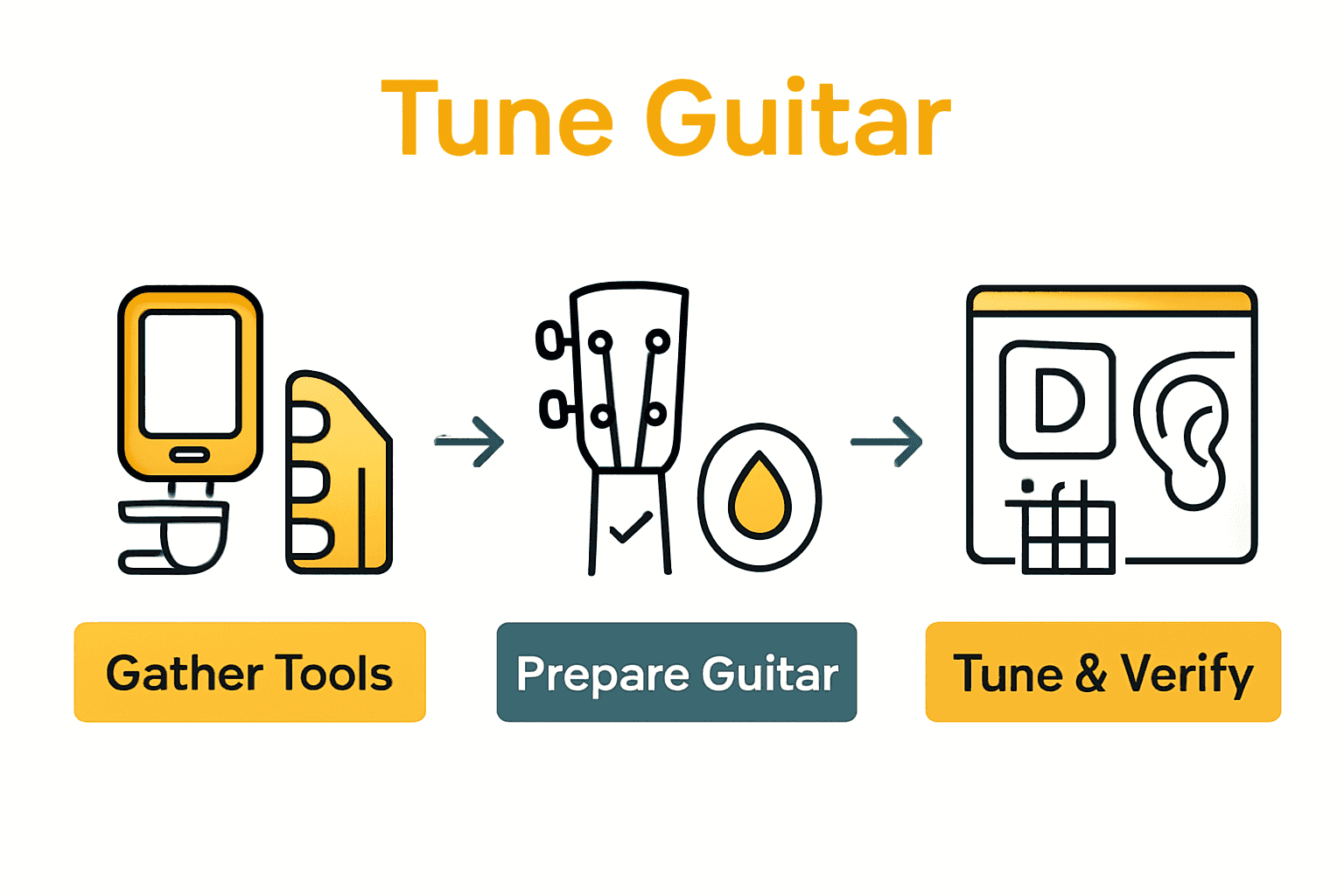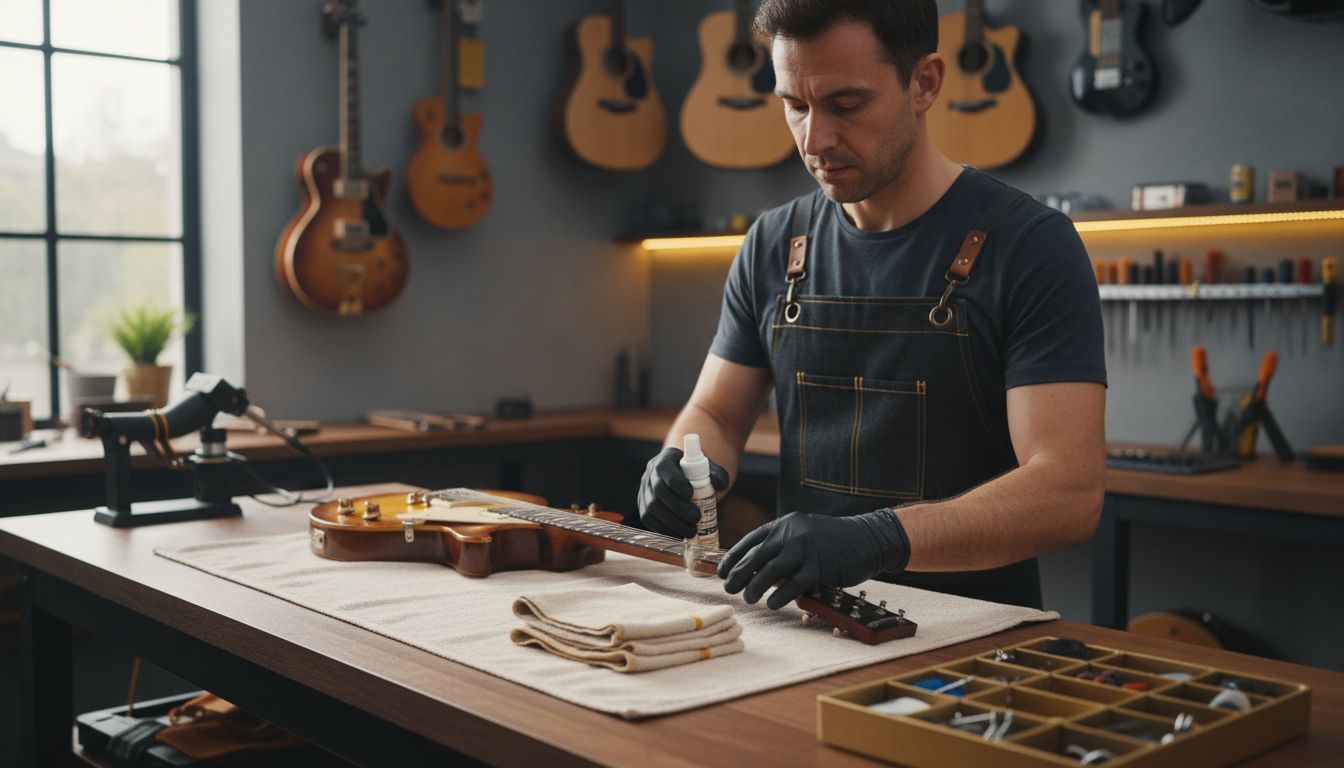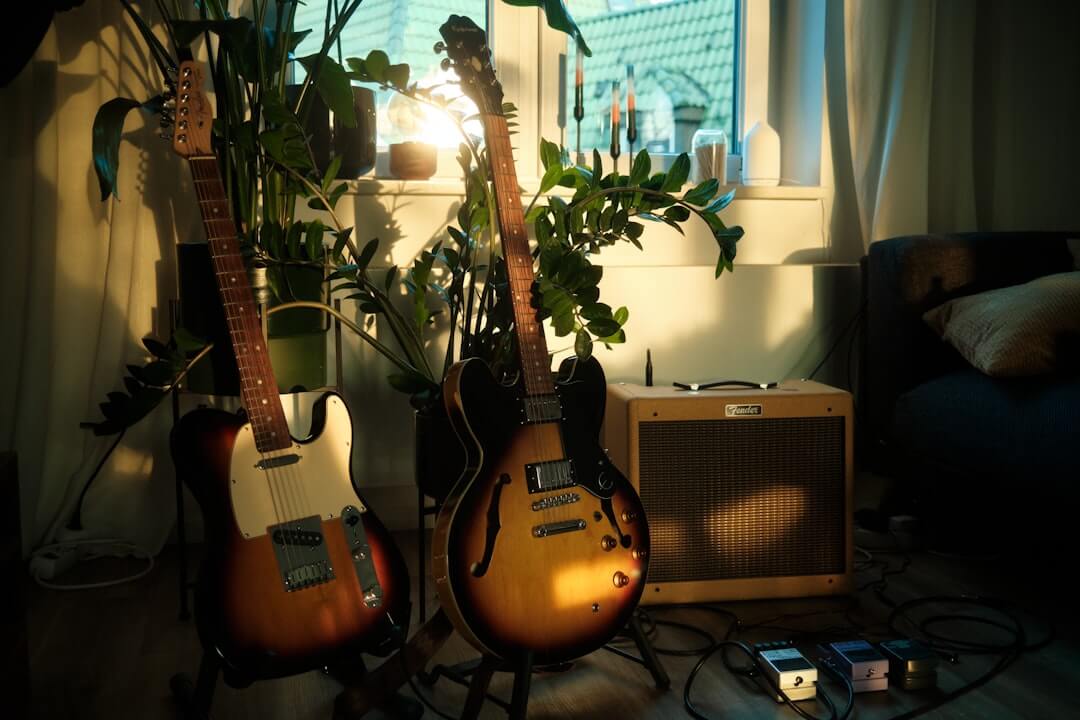Over 90 percent of beginner guitarists report frustration with tuning their instrument accurately. Clear, precise tuning is the foundation for rich sound and smooth playing, yet many players struggle to achieve it consistently. With the right approach and preparation, tuning can become quick and stress free. This guide reveals step by step how to gather essential equipment, prepare your guitar, and tune each string with confidence for perfect pitch every time.
Table of Contents
- Step 1: Gather Necessary Tuning Equipment
- Step 2: Prepare Your Guitar for Tuning
- Step 3: Select and Activate a Tuning Method
- Step 4: Tune Each String to Correct Pitch
- Step 5: Check and Adjust Tuning Accuracy
Quick Summary
| Key Point | Explanation |
|---|---|
| 1. Gather essential tuning tools | Use a digital electronic tuner for reliable pitch accuracy, and have backups like pitch pipes or tuning forks on hand. |
| 2. Prepare your guitar properly | Ensure strings are in good condition, pegs move smoothly, and humidity/temperature is stable before tuning. |
| 3. Choose a suitable tuning method | Start with electronic tuners or the 4th and 5th fret method for effective string tuning, beginning with the lowest string. |
| 4. Tune strings incrementally | Adjust tuning pegs slowly, tuning slightly below target pitch to avoid over-tightening and achieve accurate sounds. |
| 5. Verify tuning accuracy meticulously | Listen for dissonance in chords and use harmonics to confirm all strings are in tune and adjust as needed. |
Step 1: Gather Necessary Tuning Equipment
You will need several precision tools to tune your guitar accurately and achieve perfect pitch. According to research from Luth, having the right equipment is crucial for maintaining your instrument’s intonation and sound quality.
The essential tuning tools include a digital electronic tuner, which provides the most accurate results for modern guitarists. Muzician recommends additional backup options like pitch pipes and tuning forks to ensure you can tune your guitar in any situation. Digital tuners work by detecting the frequency of each string and displaying whether you are sharp or flat relative to the standard pitch. Look for a tuner with a clear display and reliable frequency detection to help you tune quickly and precisely.
One practical tip: always carry spare batteries for your electronic tuner or invest in a rechargeable model. Electronic tuners are convenient but can fail if your battery dies mid tuning session. Having a backup tuning method like a pitch pipe or tuning fork ensures you can still tune your guitar even without electronic assistance.
With your tuning equipment gathered, you’re now ready to move on to the next step of actually tuning your guitar strings to perfect pitch. Proper preparation makes the tuning process smooth and straightforward.
Step 2: Prepare Your Guitar for Tuning
Before diving into tuning your guitar, you need to ensure your instrument is ready for precise pitch adjustment. According to Luth, proper guitar setup is crucial for achieving accurate tuning and optimal sound quality.
Muzician recommends a systematic approach to preparing your guitar. Start by examining your strings carefully. Look for signs of wear such as rust, discolouration or fraying which can affect tuning stability. Check that each tuning peg moves smoothly and that the guitar neck is straight without any visible warping. Gently press down on each string at various points along the fretboard to ensure there are no dead spots or unusual buzzing sounds.
One critical preparation tip: work in a stable environment with consistent temperature and humidity. Extreme temperature changes can cause your guitar strings to expand or contract, making tuning challenging. If your guitar has been stored in a cold area, give it time to adjust to room temperature before attempting to tune.
With your guitar thoroughly checked and prepared, you are now ready to begin the precise tuning process. Proper preparation will help ensure your guitar maintains pitch accuracy throughout your playing session.

Step 3: Select and Activate a Tuning Method
Choosing the right tuning method is essential for achieving perfect guitar pitch. Luth highlights several approaches guitarists can use to tune their instruments accurately and effectively.
Muzician recommends starting with the standard electronic tuner method for most guitarists. This involves turning on your digital tuner and plucking each string individually, watching the display to see when you reach the precise pitch. For those seeking alternative methods, the 4th and 5th fret method provides a reliable manual tuning technique. In this approach, you tune strings relative to each other by comparing the pitch of fretted notes on adjacent strings.
One crucial tip: always start tuning from the lowest string and work your way up. This approach helps maintain overall string tension and prevents potential string damage. Electronic tuners work best in quiet environments where background noise won’t interfere with pitch detection.
With your tuning method selected and activated, you are now prepared to begin the precise process of bringing each string to its perfect pitch. Your careful approach will ensure your guitar sounds crisp and true.
Step 4: Tune Each String to Correct Pitch
Tuning each guitar string precisely is the most critical step in achieving perfect sound. According to Luth, accurate intonation requires careful attention to detail and understanding of pitch relationships across the fretboard.
Muzician recommends a systematic approach to tuning. Start with the low E string, plucking it and adjusting the tuning peg until your electronic tuner indicates perfect pitch. Move to the A string next, using either the electronic tuner or the 5th fret method where you compare the 5th fret of the low E string with the open A string. Continue this process for each subsequent string the D string, then G string, B string, and finally the high E string. Each time, make small incremental turns of the tuning pegs and allow the string to settle before checking again.

One critical tip: tune slightly below the target pitch and then raise the string up to the correct note. This approach helps prevent over tightening and provides more precise pitch control. Listen carefully to each string and make sure the tone is clear and stable without wavering.
With each string now carefully tuned, you are ready to perform a final check to ensure overall guitar harmony. Patience and careful listening are your best tools in achieving perfect pitch.
Step 5: Check and Adjust Tuning Accuracy
After initial tuning, verifying the precision of your guitar’s pitch is crucial to ensuring optimal sound quality. Luth emphasizes the importance of systematic checking to maintain consistent musical performance.
Muzician recommends a comprehensive approach to tuning verification. Play a few open chords and listen carefully for any dissonance or wavering between strings. Next, check your tuning using harmonics by gently touching the string at the 12th fret while plucking and comparing the harmonic pitch with the open string. This method helps identify any subtle intonation issues that might not be immediately apparent. Additionally, play scale runs up and down the fretboard to ensure each note sounds clear and true across different positions.
One critical tip: trust your ears as much as your electronic tuner. Sometimes electronic devices can be slightly off, and your musical ear is the ultimate arbiter of perfect pitch. If something sounds slightly out of tune even when the tuner suggests otherwise, make small adjustments until the sound feels right.
With your careful verification complete, your guitar is now finely tuned and ready to produce beautiful music. Remember that regular checking and minor adjustments are key to maintaining consistent sound quality.
Tune Your Guitar Like a Pro with Expert Tools and Support
Tuning your guitar to perfect pitch can be challenging without the right equipment and guidance. The article highlights common hurdles such as achieving precise pitch, maintaining tuning stability, and selecting effective tuning methods. If you want to overcome these obstacles with confidence, MusicStreet.co.uk offers a curated selection of premium guitars and essential tuning accessories to help you stay in perfect harmony. Experience the joy of flawless sound by using high-quality digital tuners, pitch pipes, and expertly maintained instruments ready for immediate play.

Don’t let imprecise tuning hold back your music. Visit MusicStreet.co.uk today to browse carefully checked guitars and essential tuning gear that empower beginners and advanced players alike. Our physical store in Huntingdon is also available for personalised setups and advice, ensuring your instrument sounds its best whenever you play. Take control of your guitar tone and start tuning with ease now at MusicStreet.co.uk.
Frequently Asked Questions
How can I gather the necessary tuning equipment for my guitar?
To tune your guitar accurately, gather essential tools like a digital electronic tuner, pitch pipe, and a tuning fork. Ensure you have spare batteries or a rechargeable model to avoid interruptions during tuning.
What steps should I take to prepare my guitar for tuning?
Before tuning, check your guitar strings for wear and ensure the tuning pegs move smoothly. Adjust the guitar’s environment to maintain consistent temperature and humidity, allowing any cold guitar to acclimate before tuning.
What tuning method should I start with for perfect pitch?
Begin with a digital electronic tuner, as it offers the most precise results. Pluck each string individually while observing the tuner display and making adjustments until you achieve the correct pitch.
How do I tune each string to the correct pitch?
Start with the low E string, adjusting it while checking the tuner. Continue tuning the A, D, G, B, and high E strings, making small adjustments and letting each string settle before rechecking.
How can I check and adjust the tuning accuracy after initial tuning?
Play open chords and listen for any dissonance, then check harmonics by touching the string at the 12th fret and comparing the pitch. Make any necessary adjustments based on what you hear to achieve a smoother sound.
What should I do if my electronic tuner shows all strings are in tune, but it sounds off?
Trust your musical ear; if the guitar sounds off, fine-tune the strings slightly—adjust lower and then raise to the correct pitch. This method helps ensure a more precise tuning that suits your playing.




Share:
How to Clean Guitar Frets for Enhanced Playability